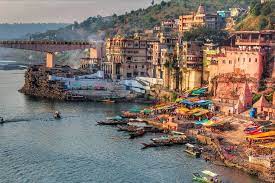Omkareshwar Temple

Omkareshwar temple is dedicated to Lord Shiva. It stands on the island of Mandhata or Shivapuri in the Narmada river. It is near Khandwa city in Khandwa district, Madhya Pradesh. The island has a shape that resembles the ॐ (Om) symbol. There are two temples. While one is the Omkareshwar temple, the other is the Amareshwar temple. The former is on the island, while the latter is on the south bank of the Narmada river on the mainland. Amareshwar, which means ‘immortal Lord’ or ‘Lord of the immortals’, is also called Mamleshwar.
Omkareshwarar temple is one of the 12 Jyotirlinga temples in the world. To the pilgrims who come here, both temples as equally sacred.
Amreshwar temple is a protected monument that boasts impressive stonework. Since the time of Maharani Ahilyabai Holkar, who died in 1795, 22 Brahmins paid by the Holkar state, used to do Lingarchan Pooja at the temple daily. Each Brahmin was given a wooden board with 1300 small holes. In each, they put a miniature clay lingam to represent the Shiva Linga. When nearly 14300 lingas were manufactured and worshipped, they would be immersed in the Narmada. In the early part of the 20th century, the number of Brahmins came down to 11. At present, there are only 5 Brahmins. The temple walls have inscriptions of Mahims Stotra, dated 1063 AD.
On completing their pilgrimage, all Hindus visit Omkareshwar and offer holy water at the temple. Only then, their pilgrimage is complete.
Omkareshwar temple is a huge attraction for devout Hindus who visit the place. Not much is known about who built the temple or when it was built. The sanctum sanctorum, which contains the Jyotirlinga, was originally a small temple in the old construction style. Its dome comprises layers of stone slabs, not circular cut stones.
As the temple lies very close to the precipitously deep bank of the Narmada river to the south, the extension is in a new style of construction. This is why neither the sanctum sanctorum or the main deity are in front of the main door. Nor are they below the higher conspicuous Shikhar (the tower constructed later).
Legends behind the Temple
One legend says that Sage Narada, who is the son of Lord Brahma, visited the Vindhya Parvat (mountain) once and told him that Mt. Meru was larger. This made Vindhya Parvat jealous. Determined to become taller than Meru, Vindhya Parvat began to worship Lord Shiva, seeking his blessings to become taller. Lord Shiva was pleased and granted him his wish. As per a request from all the Gods, Shiva divided the linga into two parts. One would be in Omkareshwar, and the other would be in Amareshwar. He also said that Vindhya Parvat would never stop growing. But he also said that Vindhya should not create any problems for the people. Vindhya agreed.
However, Vindhya did not keep his promise to Shiva. Soon, he began to obstruct even the Sun and the Moon. The Gods went to Sage Agastya and sought his help. Sage Agastya and his wife extracted a promise from Vindhya that he would not grow until they returned. Vindhya agreed. The sage and his wife left, but they never returned. They remained in Srisailam, which is also called Dakshina Kashi and is one of the Dwadashi Jyotirlingas.
The second story is about King Mandhata and his son’s penance. Mandhata belonged to the Ikshvaku clan and was the ancestor of Lord Rama. He worshipped Shiva here until the Lord appeared before him as a Jyotirlinga. Some believe that Mandhata’s sons, Ambarish and Muchukunda, did severe penance here and appeased Shiva. Hence, the mountain got the name, Mandhata.
The third story comes from the Hindu scriptures. Once, there was a great battle between the gods and the demons. The demons won the battle, and so the gods prayed to Lord Shiva. Pleased with their prayers, Shiva appeared as Omkareshwar Jyotirlinga and defeated the demons.
Omkareshwar is supposedly the place where Adi Sankara met his guru, Govinda Bhagavatpada, in a cave. The cave exists even now. It is just below the Shiva temple, and an image of Adi Shankara is present here.
Temple Architecture
The temple has a grand Sabha Mandap, which is a meeting or prayer hall. It rests on about 60 huge brown stone pillars (14 feet high), carved elaborately with a curious frieze and fillet of satyrlike images. Many of these figures have broad shoulders and are in meditating poses. The temple has 5 storeys, and each houses a different deity.
There are 3 regular Pooja services in the temple. The morning Pooja is performed by the temple trust. The afternoon Pooja is performed by the priest of the Scindia state, while the evening Pooja is performed by the priest of the Holkar state.
The temple attracts a lot of pilgrims. They visit the temple after taking a bath in the Narmada. They bring with them pots filled with Narmada water, coconuts, and various articles of worship. Many also perform Abishek through the priests.



